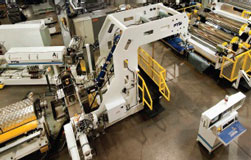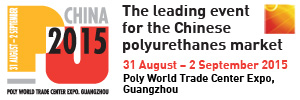Also, download this story from the electronic issue here

US-based sheet extrusion machinery maker Processing Technologies International (PTi) showcased at the NPE exhibition in Orlando recently an 85mm/52D HVTSE extruder and a GCH661824 horizontal roll stand, capable of producing 57” wide PET/ PLA sheet at thicknesses down to 0.2 mm or PP sheet at thicknesses down to 0.3 mm. This system operates at 1,000 kg/ hour or a total of 8,000 tonnes/year of PET production. It will be the fourth installation in the last six months, and, in addition to the units sold from the 2011 launch, will represent a theoretical installed capacity of 180,000 tonnes/year of North American PET production.
The “dryerless” sheet extrusion system is an eco-conscious manufacturing solution, which delivers major energy and cost savings, according to the firm. In terms of sustainability, the HVTSE process provides a reduction of about 80-85 kWh/450 kg in energy consumption versus conventional PET processing.
The line unit boasts several novel features including PTi’s new GSeries configurable roll stand, PTi’s Titan Plus Integrated PLC control system, multi-resin capability and rapid resin changeover.
Meanwhile PTi is also in the final stages of formalising a commercial agreement with a tooling manufacturer for the exclusive sourcing of its patented layerflipping technology. This technology allows processors to quickly change the position of extrudates from two extruders in a coextruded structure without disassembly and shutdowns.
Changeovers in piston position due to hydraulic actuation of the piston cylinder and unique flow design are accomplished in a matter of seconds as opposed to conventional techniques which require some machine disassembly and could take up to several hours, according to PTi.
The diverter valve, which can be utilised on new or existing systems, features a dual-piston valve that is moveable in a stationary body. The body has two entrances that feed from separate extruders. The first position of the valve allows the material to enter the piston valve and permits a straight through flow path. Normally, this would produce an A-B structure. When the alternated position two is selected, the materials are routed through crossover flow paths that changes extrudate positions. This produces a B-A structure.
During position changes, a unique flushing channel design keeps flow from stagnating for quick and efficient changeovers. The practical use for the diverter valve is its quick “realtime” purging of cap layers in a multilayer co-extrusion structure for sheet production. The diverter valve enables the processor to purge the cap layer extruder back into the inner layer of the structure while an alternate cap layer extruder runs a specific resin formulation (i.e., different colour). Each cap layer (both inner and outer layers) can utilise this special valve to permit this real-time purging for rapid changeovers. This occurs without shutting down the line, thus permitting recovery of the purged resin directly back into the structure instead of losing the material onto the production floor and recovery through a grinder.
PTi will offer the layer-flip technology on new co-extrusion systems or as a retrofit to existing machines.
(PRA)
































